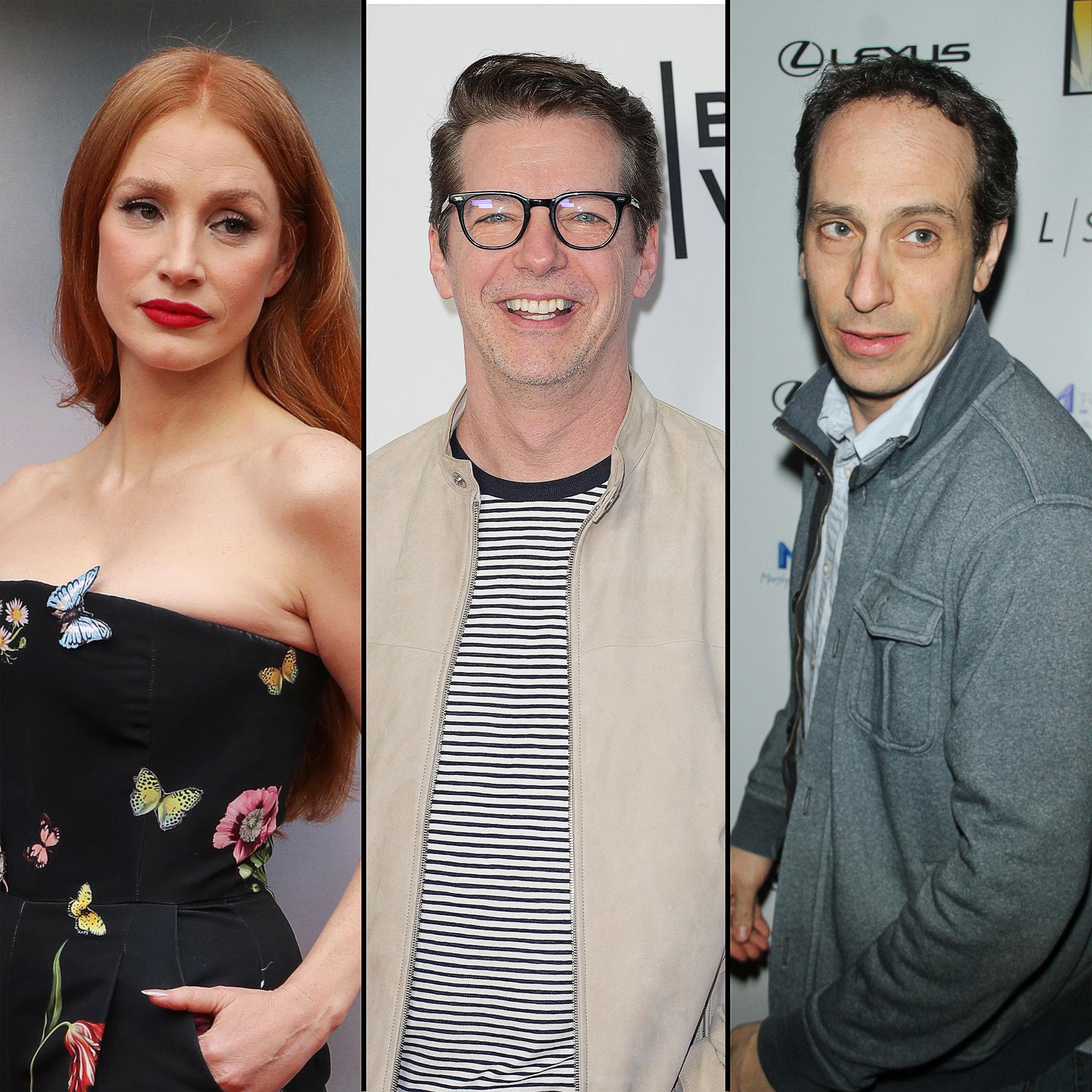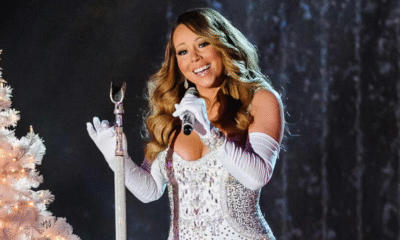Entertainment
Jessica Chastain and Sean Hayes Swap Stage Horror Stories — And Yikes on August 14, 2023 at 11:41 pm Us Weekly

Jessica Chastain, Sean Hayes, Peter Gross. Shutterstock (3)
Jessica Chastain and Sean Hayes revealed their biggest “nightmare” — and admittedly “gross” — on stage moments of all time.
“I threw up [on stage]. I threw up and I swallowed it. And no one knew,” Chastain, 46, said during the most recent episode of the “SmartLess” podcast. “From then on I was like, ‘I’m not eating within three hours of the show. I’ll just drink water.’ I don’t know if I was nervous — I was kind of sobbing and I, like, leaned over and it happened. And I was like, ‘Oh my God.’ You can’t let it out of your mouth.”
Chastain added that because there was no intermission, “for the rest of the show I couldn’t tell anyone because I was on a chair facing the audience.” That meant she couldn’t even warn her costar before they shared an intimate smooch.
“I had to kiss someone! It was a nightmare and I couldn’t explain,” she told hosts Jason Bateman, Will Arnett and Hayes, 53. “And then the second we had the curtain call and the curtain came down, I said, ‘You guys I am so sorry. I vomited.’”
Chastain explained that while it was a “closed-mouth kiss” that night, it was still a “sensual” one. “Even talking to someone I was just so [embarrassed],” she said.
After Chastain detailed her most uncomfortable Broadway moment, Hayes offered his own worst memory.
“In [my] show [Good Night, Oscar] I have to scream at Peter Gross. We get in a screaming match and we’re literally nose to nose,” he said. “And one night, this was just a couple weeks ago, I don’t know what happened but so much saliva came spewing from my mouth. It was all over his face.”
He continued: “And then that night he was so sweet about it. He goes. ‘Hey, can I talk to you about that? … Is there any way you could just spit a little less when we argue?’ And I was like, ‘Absolutely!’ He was so sweet about it.”
The twosome may have nightmare stories to share, but both Hayes and Chastain have had an incredibly successful few years. In addition to “SmartLess” being one of the most listened-to podcasts, Hayes took home the Tony Award for Best Actor in a Play in June. Hayes stars as Oscar Levant in the Broadway play, which opened at the Belasco Theatre in April.
Chastain, meanwhile, nabbed her own nomination for a 2023 Tony for her performance in A Doll’s House, which premiered at the Big Apple’s Hudson Theatre in March and ran through June. She also won an Academy Award and Screen Actors Guild Award last year for her portrayal of country singer Tammy Wynette in the miniseries George & Tammy.
“To have the most incredible past couple of years … It’s also been more of me producing the projects,” Chastain told Vanity Fair earlier this month. “As women get older in the industry, we need to become more active in producing projects in order for us to have a place here — because no one else will do it for us.”
She added: “I watched the industry for a long time before I had the opportunity of working in it, and I gathered a lot of information. It has changed quite a bit,” Chastain said of how Hollywood has evolved in recent years. “The whole #MeToo culture, which I am appreciative of, the idea that there’s now more resources for people who feel like they’re in an unhealthy, abusive situation. “
Now, Chastain is ready to slow down — and is considering taking on a slightly less emotionally taxing role.
“We did 137 performances but [A Doll’s House] was pretty emotional. There was heavy crying for, like, an hour each show. It’ll have another life next year but much shorter runs otherwise I’ll lose my mind. … I just become so raw,” Chastain quipped during her “SmartLess” podcast appearance. “Which is why I’m looking forward to playing another Zero Dark Thirty character who really doesn’t give a s—t. She’s just walking through. I need to play that next.”
Jessica Chastain and Sean Hayes revealed their biggest “nightmare” — and admittedly “gross” — on stage moments of all time. “I threw up [on stage]. I threw up and I swallowed it. And no one knew,” Chastain, 46, said during the most recent episode of the “SmartLess” podcast. “From then on I was like, ‘I’m
Us Weekly Read More
Entertainment
What We Can Learn Inside 50 Cent’s Explosive Diddy Documentary: 5 Reasons You Should Watch

50 Cent’s new Netflix docuseries about Sean “Diddy” Combs is more than a headline-grabbing exposé; it is a meticulous breakdown of how power, celebrity, and silence can collide in the entertainment industry.
Across its episodes, the series traces Diddy’s rise, the allegations that followed him for years, and the shocking footage and testimonies now forcing a wider cultural reckoning.

1. It Chronicles Diddy’s Rise and Fall – And How Power Warps Reality
The docuseries follows Combs from hitmaker and business icon to a figure facing serious criminal conviction and public disgrace, mapping out decades of influence, branding, and behind-the-scenes behavior. Watching that arc shows how money, fame, and industry relationships can shield someone from scrutiny and delay accountability, even as disturbing accusations accumulate.

2. Never-Before-Seen Footage Shows How Narratives Are Managed
Exclusive footage of Diddy in private settings and in the tense days around his legal troubles reveals how carefully celebrity narratives are shaped, even in crisis.
Viewers can learn to question polished statements and recognize that what looks spontaneous in public is often the result of strategy, damage control, and legal calculation.
3. Survivors’ Stories Highlight Patterns of Abuse and Silence
Interviews with alleged victims, former staff, and industry insiders describe patterns of control, fear, and emotional or physical harm that were long whispered about but rarely aired in this detail. Their stories underline how difficult it is to speak out against a powerful figure, teaching viewers why many survivors delay disclosure and why consistent patterns across multiple accounts matter.
4. 50 Cent’s Approach Shows Storytelling as a Tool for Accountability
As executive producer, 50 Cent uses his reputation and platform to push a project that leans into uncomfortable truths rather than protecting industry relationships. The series demonstrates how documentary storytelling can challenge established power structures, elevate marginalized voices, and pressure institutions to respond when traditional systems have failed.
5. The Cultural Backlash Reveals How Society Handles Celebrity Accountability
Reactions to the doc—ranging from people calling it necessary and brave to others dismissing it as a vendetta or smear campaign—expose how emotionally invested audiences can be in defending or condemning a famous figure. Watching that debate unfold helps viewers see how fandom, nostalgia, and bias influence who is believed, and why conversations about “cancel culture” often mask deeper questions about justice and who is considered too powerful to fall.
Entertainment
South Park’s Christmas Episode Delivers the Antichrist

A new Christmas-themed episode of South Park is scheduled to air with a central plot in which Satan is depicted as preparing for the birth of an Antichrist figure. The premise extends a season-long narrative arc that has involved Satan, Donald Trump, and apocalyptic rhetoric, positioning this holiday episode as a culmination of those storylines rather than a stand‑alone concept.
Episode premise and season context
According to published synopses and entertainment coverage, the episode frames the Antichrist as part of a fictional storyline that blends religious symbolism with commentary on politics, media, and cultural fear. This follows earlier Season 28 episodes that introduced ideas about Trump fathering an Antichrist child and tech billionaire Peter Thiel obsessing over prophecy and end‑times narratives. The Christmas setting is presented as a contrast to the darker themes, reflecting the series’ pattern of pairing holiday imagery with controversial subject matter.
Public and political reactions
Coverage notes that some figures connected to Donald Trump’s political orbit have criticized the season’s portrayal of Trump and his allies, describing the show as relying on shock tactics rather than substantive critique. Commentators highlight that these objections are directed more at the depiction of real political figures and the show’s tone than at the specific theology of the Antichrist storyline.
At the time of reporting, there have not been widely reported, detailed statements from major religious leaders focused solely on this Christmas episode, though religion-focused criticism of South Park in general has a long history.
Media and cultural commentary
Entertainment outlets such as The Hollywood Reporter, Entertainment Weekly, Forbes, Slate, and USA Today describe the Antichrist arc as part of South Park’s ongoing use of Trump-era and tech-world politics as material for satire.
Viewer guidance and content advisory
South Park is rated TV‑MA and is intended for adult audiences due to strong language, explicit themes, and frequent use of religious and political satire. Viewers who are sensitive to depictions of Satan, the Antichrist, or parodies involving real political figures may find this episode particularly objectionable, while others may view it as consistent with the show’s long‑running approach to controversial topics. As with previous episodes, individual responses are likely to vary widely, and the episode is best understood as part of an ongoing satirical series rather than a factual or theological statement.
Entertainment
Sydney Sweeney Finally Confronts the Plastic Surgery Rumors

Sydney Sweeney has decided she is finished watching strangers on the internet treat her face like a forensic project. After years of side‑by‑side screenshots, “then vs now” TikToks, and long comment threads wondering what work she has supposedly had done, the actor is now addressing the plastic surgery rumors directly—and using them to say something larger about how women are looked at in Hollywood and online.

Growing Up on Camera vs. “Before and After” Culture
Sweeney points out that people are often mistaking normal changes for procedures: she grew up on camera, her roles now come with big‑budget glam teams, and her body has shifted as she has trained, aged, and worked nonstop. Yet every new red‑carpet photo gets folded into a narrative that assumes surgeons, not time, are responsible. Rather than walking through a checklist of what is “real,” she emphasizes how bizarre it is that internet detectives comb through pores, noses, and jawlines as if they are owed an explanation for every contour of a woman’s face.
The Real Problem Isn’t Her Face
By speaking up, Sweeney is redirecting the conversation away from her features and toward the culture that obsesses over them.
She argues that the real issue isn’t whether an actress has had work done, but why audiences feel so entitled to dissect her body as public property in the first place.
For her, the constant speculation is less about curiosity and more about control—another way to tell women what they should look like and punish them when they do not fit. In calling out that dynamic, Sweeney isn’t just defending herself; she is forcing fans and followers to ask why tearing apart someone else’s appearance has become such a popular form of entertainment.

 Entertainment4 weeks ago
Entertainment4 weeks agoColombia’s ‘Doll’ Arrest: Police Say a 23-Year-Old Orchestrated Hits, Including Her Ex’s Murder

 Entertainment4 weeks ago
Entertainment4 weeks agoHow The Grinch Became The Richest Christmas Movie Ever

 Entertainment4 weeks ago
Entertainment4 weeks agoMiley Cyrus Is Engaged to Maxx Morando

 Film Industry3 weeks ago
Film Industry3 weeks agoDisney Brings Beloved Characters to ChatGPT After $1 Billion OpenAI Deal

 Business4 weeks ago
Business4 weeks agoLuana Lopes Lara: How a 29‑Year‑Old Became the Youngest Self‑Made Woman Billionaire

 Entertainment4 weeks ago
Entertainment4 weeks agoMariah Carey’s One Holiday Hit Pays her $3.3 Million a Year

 Film Industry3 weeks ago
Film Industry3 weeks agoNetflix Got Outbid: Paramount Drops a $108 Billion Cash Bomb on Warner Bros.

 Entertainment4 weeks ago
Entertainment4 weeks agoAnne Hathaway Just Turned Her Instagram Bio Into a 2026 Release Calendar



























